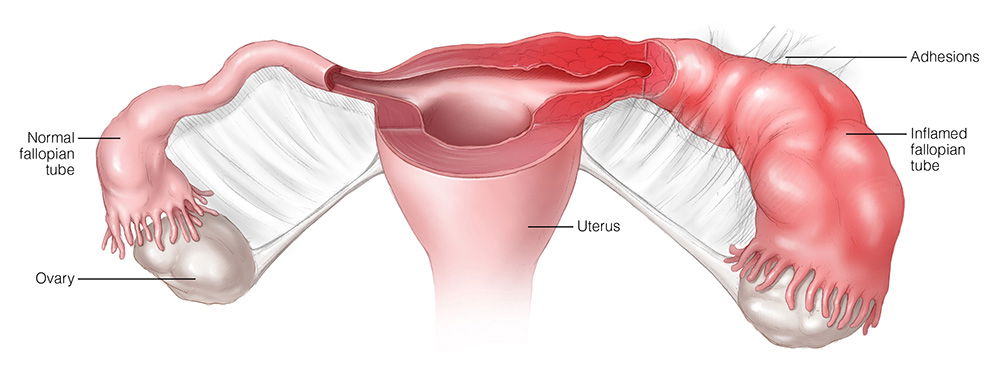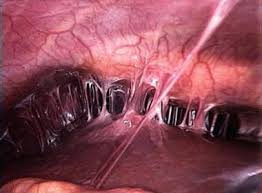Enfermedad inflamatoria pélvica (PID)

Introduction
Pelvic inflammatory disease or PID is an infection of the uterus, fallopian tubes and/or ovaries caused by migration of bacteria usually acquired from sexually transmitted diseases (STDs), particularly gonorrhea and chlamydia. Pelvic inflammatory disease may or may not cause symptoms. It is very important for this condition to be diagnosed and treated. Untreated or severe pelvic inflammatory disease can lead to infertility,ectopic pregnancy,chronic pelvic pain or other serious consequences. PID is common among sexually active women; an estimated one million American women and teens experience an episode of PID each year. It It causes infertility in about 100,000 women annually, as well as a significant percentage of ectopic pregnancies as a result of damage to the lining of the tube.
Besides STDs, other contributing factors may be douching (which can flush bacteria from the vagina up into the uterus, fallopian tubes and ovaries). There is no evidence that it is caused by IUD.
Anatomy
The internal female reproductive system includes the ovaries, fallopian tubes, uterus, cervix, and vagina. The ovaries are two small organs that produce eggs (ova) and hormones. An ovary typically releases one mature egg each month. Two fallopian tubes extend from near the ovaries to the uterus. The fallopian tubes transport the mature eggs to the uterus.
The uterus is a pear-shaped organ where a baby grows in during pregnancy. The lining of the uterus undergoes cyclic changes to facilitate and maintain pregnancy. The uterus is joined to the vagina by the cervix. The vagina is a muscular passageway that extends from the cervix to the external female genitalia.
Causes
Pelvic inflammatory disease is an infection in the uterus, fallopian tubes, or ovaries. The majority of cases are caused by bacteria from sexually transmitted diseases, including Chlamydia and gonorrhea. Pelvic inflammatory disease may result when bacteria enter the body during procedures, such as childbirth, miscarriage, abortion, endometrial biopsy, and intrauterine device insertion.
Pelvic inflammatory disease is common in the United States. Many women may not experience symptoms and may not realize that they have it or do not seek treatment. Pelvic inflammatory disease can cause infertility, and many women may not discover that they have it until they experience difficulty conceiving or complications during pregnancy.

Symptoms
Pelvic inflammatory disease may or may not cause symptoms. Changes in the color, odor, and consistency of vaginal discharge are common. Other common symptoms include abdominal pain, fever irregular periods, pain during intercourse or pain during a pelvic exam. You may experience irregular or absent menstrual bleeding, painful urination, pain during sexual intercourse, fatigue, nausea, or vomiting.
Diagnosis
It is suspected that pelvic inflammatory disease is greatly underdiagnosed. You should talk to your doctor about your risk factors, sexual history, and concerns. Contact your doctor if you experience the symptoms of pelvic inflammatory disease or a sexually transmitted disease.
Your doctor can begin to diagnose a sexually transmitted disease, bacterial infection, or pelvic inflammatory disease by completing a physical examination and some tests. During your pelvic examination, cultures will be taken to test for sexually transmitted diseases.
Imaging tests such as an ultrasound or computed tomography (CT) scans may be used to examine the structure of your reproductive organs. A laparoscopy may be used to confirm the diagnosis and determine the extent of your condition. A laparoscopy is a minimally invasive surgical procedure that uses a laparoscope to view the reproductive organs. A laparoscope is a thin tube with a light and viewing instrument that is inserted through a small incision in your abdomen. Images from the laparoscope are sent to a video monitor.
Treatment
Antibiotics are used to treat pelvic inflammatory disease in the majority of cases. Your sexual partner should be examined for sexually transmitted diseases and treated as well. Severe cases of pelvic inflammatory disease may require hospitalization and intravenous (IV) antibiotics. In rare cases, surgery may be necessary.
Prevention
You may prevent pelvic inflammatory disease by avoiding exposure to sexually transmitted diseases disease by abstinence or having a monogamous relationship with a partner that does not have sexually transmitted diseases. Couples that have had multiple sex partners should be tested and treated for sexually transmitted diseases before engaging in sexual relations. Proper use of condoms reduces, but does not completely eliminate, the risk of contracting sexually transmitted diseases. If you participate in high-risk sexual activity, your doctor can help you establish a regular screening schedule. You should contact your doctor if you develop the symptoms of a sexually transmitted disease or suspect that you have pelvic inflammatory disease.
Am I at Risk
Risk factors for pelvic inflammatory disease:
_____ Teenagers that are sexually active before the age of 20 have an increased risk for pelvic inflammatory disease. The National Institutes of Health estimate that 1 in 8 sexually active teenage females develops pelvic inflammatory disease before the age of 20.
_____ Having multiple sex partners increases your risk of contracting the sexually transmitted diseases associated with pelvic inflammatory disease.
_____ If you have a past history of sexually transmitted diseases or pelvic inflammatory disease, your risk is increased.
_____ IUD placement may increase your risk for pelvic inflammatory disease.
_____ Certain recent gynecological procedures, including childbirth, miscarriage, abortion, or endometrial biopsy may increase your risk for contact with the bacteria that causes pelvic inflammatory disease.
Complications
It is important for pelvic inflammatory disease to be diagnosed and treated as soon as possible. Pelvic inflammatory disease can cause scarring and infection in the fallopian tubes that can lead to infertility. It can also cause ectopic pregnancy, a life-threatening abnormal pregnancy. Pelvic inflammatory disease can cause peritonitis, an inflammation of the surrounding abdominal cavity lining. It may spread to the blood if the bacteria enter your blood stream. it can lead to scarring and adhesions that can reach the upper abdomen and cause chronic pain. This is called Fitz-Hugh-Curtis syndrome.
References
- American College of Obstetricians and Gynecologists. Gynecological Problems: Pelvic Inflammatory Disease. 2004. www.acog.org/publications/patient_education.pdf/bp077.cfm.
- National Women’s Health Resource Center, Inc. Your Guide to Uterine Health. www.healthywomen.org
- www.cdc.gov/std/PID/STD-Fact/PID/htm.
